LG recently released its first soundbar with Dolby Atmos. As with other manufacturers, it is a high-end device that ideally belongs to a large premium television. The LG SJ9 also has nice streaming options.
Soundbars with dolby Atmos
The LG SJ9 enters an increasingly crowded arena. There are more and more soundbars with support for Dolby Atmos , one of the new surround codecs with extra sound channels in height. The intention is for the additional sound to complement the existing surround channels at ear height, thereby giving a sound experience that surrounds you even more. This technique has been used for a while in cinemas, where of course many more speakers hang.
Earlier, we reviewed the Yamaha YSP-5600, Samsung HW-K950 and Philips Fidelio B8, three soundbars with Atmos support. The first two are much higher priced than the SJ9, partly because they apply additional technologies (respectively sound projection and wireless speakers in the back of the room) to provide an Atmos experience of a high level. The LG soundbar is technically more like the Philips B8: it offers 5.1.2 channel audio and consists of a single soundbar with a wireless subwoofer. In this test we investigate whether the LG SJ9 is capable of giving a convincing surround experience with and without Atmos.
This is the LG SJ9
If you know the latest line of OLED TVs from LG, the SJ9 is immediately familiar. The spectacularly thin Signature W OLED television that LG presented at CES 2017 in January comes with a very similar soundbar. But the two LG soundbars are not quite right, because the soundbar with this so-called wallpaper-OLED of 2.57 mm thick has two overhead speakers that slide out of the housing as soon as you turn on the television. Unfortunately, the SJ9 keeps it on a fixed grille near the two upward-facing speakers. The speakers that automatically rise from the case at the Signature soundbar are very impressive.
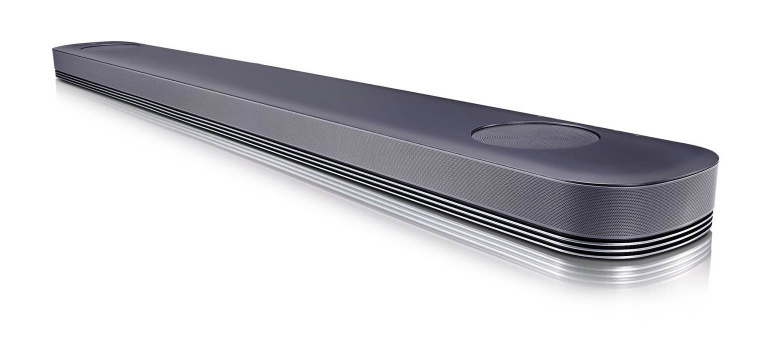
The SJ9 is a decent sound bar 1.2 meters wide. We place it with our LG OLED55B6 and it still sticks out a bit on each side. So you want to combine this soundbar with a television of 55 inch or larger. Put it under a 40-inch device and it actually looks a bit absurd. Fortunately, the height of 5.8 cm is fairly modest. The bottom screen edge of most TVs will not be covered.
You can hang up the SJ9. Just like the Samsung HW-MS650 that we have recently tested, you can only do so by hanging the soundbar so that it sticks out. Personally we find that less beautiful than a soundbar that hangs flat against the wall. After wall mounting it is in any case difficult to reach the connections, so cables should be connected in advance.

Because of its large depth and the overhead speakers you can only place the SJ9 in front of a TV and free on a piece of furniture, not on a shelf in a TV cabinet for example. In comparison with many other soundbars, the placement options are therefore more limited. This ‘problem’, if it can be called that, is what you get with most Atmos sound bars. The speakers at the top, which make Atmos possible, have to be able to radiate towards the ceiling.
Sleek appearance
In terms of looks, the SJ9 has something futuristic, with its rounded ends and grille that runs around the device. The three metal lines that also run around the soundbar at the bottom give a certain premium appearance. You can also say that about the subwoofer, which is fairly sober but has been finished correctly. In the past you could criticize LG for that. The wireless subwoofer is quite large (29.6 x 33.2 x 29.6 cm), but to our surprise it is not as heavy as you might expect.

A drawback on design level is the included remote control. Ok, most people will control the volume via the remote control of the TV or via an app, but still the remote of the SJ9 could be more spacious. LG provides a small thing that is functional, but that you will also find in the box at much cheaper LG soundbars. The contrast with the SJ9 itself, which is quite well finished, is a bit too big.
Connection options
As you would expect at a soundbarfrom the more expensive segment you have some options for connecting your television and other devices. Connecting the TV via HDMI-ARC is recommended, because you can then count on good sound quality and use the remote of your television to control the volume. There is also an optical input if you prefer that for your TV connection. The soundbar is also suitable as a music source, such as a CD player or a console. If you have a recent LG TV, you can also connect to the TV via the ‘LG TV’ option. It is funny that LG offers this ‘connection’ separately in the menu. Actually, audio is wirelessly streamed via Bluetooth, while ‘Bluetooth’ also appears as a separate choice in the input list. Via Bluetooth you can connect wirelessly to a smartphone or tablet, but also with TVs from other brands that have a Bluetooth transmitter. There are more and more. But this option is not recommended, unless you really strive for a cable less. Bluetooth is a lossy transport medium that sometimes has some problems with synching. In our tests, the TV sound through Bluetooth sometimes faltered, even though the soundbar and television were about ten centimeters apart.

The SJ9 has one additional HDMI input that you can use for a video source. A digital TV decoder for example, but in the case of this soundbar you better connect your (Ultra HD) Blu-ray player here. After all, you want to experience films with Dolby Atmos soundtracks and these are almost exclusively available through Blu-ray movies, both ‘normal’ Full HD Blu-rays and Ultra HD Blu-rays. If you connect a disk player directly to the TV, then the chance is real that you will not get Atmos with the SJ9. Only a handful of TVs (including the 2017 OLEDs from LG) send Dolby Digital + over ARC, so the extra Atmos information arrives at the soundbar. In short: connect the player directly to the SJ9, then you are at least certain that your Atmos soundbar also effectively receives Atmos. Finally, there is a 3.5 mm jack input to connect a music player.
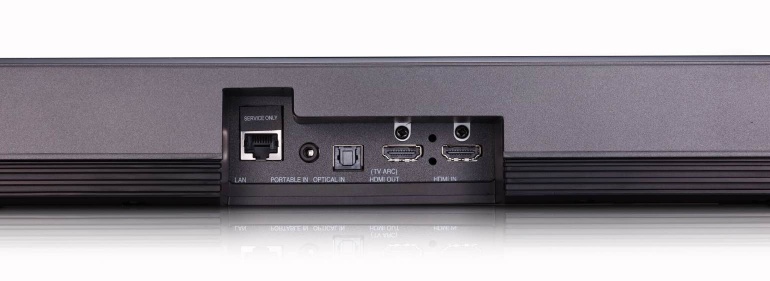
LG has done its best to keep cables out of sight as far as possible. All connections are placed in a discrete niche at the back. If you are a little handy, you can easily get rid of everything.
Streaming with the LG SJ9
Strictly speaking, the SJ9 still has an ‘entrance’: WiFi. You can optionally connect the SJ9 to your wireless or wired network, after which the soundbar gets a lot of streaming possibilities. You can stream via the Music Flow app from LG itself, but because the SJ9 is DLNA-compatible you can use another DLNA controller app if you wish. During our tests we were able to easily send our own hi-res ALAC files from our NAS to the SJ9 via BubbleUPnP on Android. LG also offers a Windows app to share music files over the network via DLNA. In any case, it is a good idea to install Music Flow Player (iOS and Android), if only to connect the SJ9 to the wireless network. The instructions in the app to do that are clear.
The LG app has been around for a while and we have already met in previous tests. LG launched it for its Music Flow multiroom family, to which this SJ9 also belongs. In other words, via the Music Flow Player app you can control the SJ9 but also control other Music Flow products, such as the H3 or H5 wireless speakers. Placing multiple Music Flow products in the same zone so that they play the same track should also be possible, but that failed due to lack of additional Music Flow devices this time. We have done so in the past, with two main trump cards: the Music Flow devices played a lot of formats, including hi-res PCM such as FLAC and Apple Lossless, and they deploy mesh networking to ensure very good network stability. and range.

The Music Flow app has not really changed over the years, but has become somewhat simpler. Among other things, the music advice function has disappeared, making the app less pressure. A lot of advice did not give that function anyway, so nobody will miss it. In the app, the support for streaming services that are relevant to our country remains rather modest: Spotify, Google Play and TuneIn (internet radio). But we really do not mind, because the SJ9 also has Chromecast built-in on board. You can stream music from a large number of apps, including Deezer, Tidal, Qobuz, SoundCloud and many more. That is good.
The app also shows that the LS9 can be combined with two wireless rear-speakers, but we could not test that and LG could not tell us whether this was possible. Since two separate rear-speakers may be able to address a weakness of this soundbar (see below), we will supplement this review as soon as we receive relevant new information from LG.
What does it sound like?
Because of the nice streaming possibilities we decided to test the SJ9 for its musical possibilities. Through BubbleUPnP we play some hi-res ALACs from our Synology NAS, including Björk’s ‘Vulnicura’ album in 96 kHz / 24 bit. Playing these files correctly is not a challenge for the LG soundbar. It even sounds pretty good for a soundbar. Especially the typical hesitant voice of Björk Guðmundsdóttir is of course in the room.

We initially placed the subwoofer next to our seat. During listening to music we notice that a piece of sound information is not from the soundbar but from the sub. So he plays a bit too high, something that we often notice with soundbar subwoofers. It is not a huge problem with the SJ9, but we would still recommend to place the sub in the vicinity of the TV screen. At the front of the living room.
To see if the SJ9 performs well in terms of Atmos, we first pick up our official Atmos test disc, played on a Samsung UBD-K8500 UHD player directly connected to the LG soundbar. If we first go through the 5.1.2 test tones, we will indeed notice that the sub plays a role. There is a clear placement at L-Center-R and the two height channels, the two rear channels sound more from the back of the soundbar. When we then listen to the typical Atmos demos (including 747 Takeoff, Audiosphere, Leaf and Rainstorm), we record a fairly realistic sense of depth and spaciousness. The upper speakers provide a sound that also has depth in the depth, although the sound comes from the soundbar itself rather than from the ceiling.
A jammer for some demos are the rear channels. Because they seem to sit in the front of the room, you sometimes get an inverse effect. The plane in ‘747 Takeoff’ seems to fly away in front of you, while he actually has to shave over you and away from your back. The SJ9 does not sound bad at all, only the sound is sometimes not correct. At the Leaf-demo you can hear the winged seed (a samara, according to biologists), roaming around the forest.

Demos are of course only demos. We extract our Ultra HD Blu-rays from the ‘Expendables 3 (Extended Version)’ and ‘X Men Apocalypse’. In the latter film, for example, the SJ9 brings the great scene to life where Quicksilver saves all students from the detonating Xavier’s School for Gifted Youngsters in bullit-time on the notes of ‘Sweet Dreams’ by Eurythmics. While this iconic tune plays in the background, the SJ9 serves the deep sounds of the disintegrating school building beautifully in height, while the footsteps and other sounds of Quicksilver follow the action perfectly. In both films we note that the SJ9 smears the action wide in the room, both horizontally and vertically. All the action takes place at the front of the room.
Also good to know: the SJ9 will send a part of the sound through 5.1-streams – that is, without Atmos-information. As we noticed when we watched ‘Divergent’ via the Netflix app on our LG TV, you should switch to ASC sound mode. The upper speakers are then switched off, which in this case sounded more natural. The sound that came from those upper speakers was, after all, rather artificial in nature.
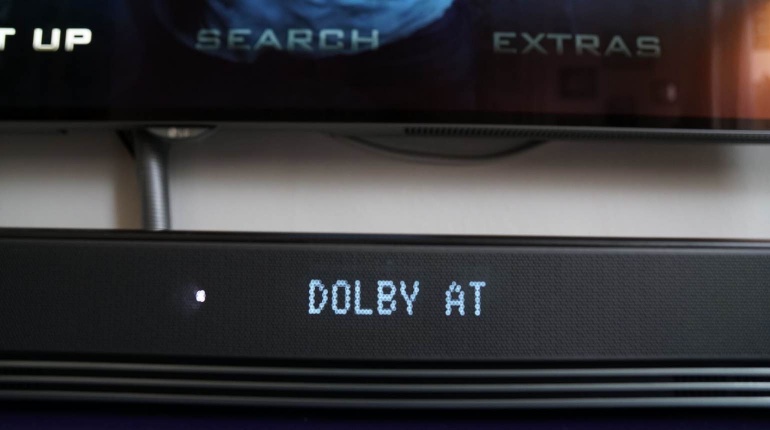
Like many Atmos sound bars, the LG SJ9 does not support DTS: X. At the moment there are many more films with Atmos soundtracks, but gradually we see the first DTS: X Blu-ray films in stores. The recent release of ‘Jason Bourne’, for example, has a DTS: X soundtrack, not Dolby Atmos. For the time being Atmos is still overwhelming in the majority and we even suspect that this will not change soon, but we wonder how the situation will look in a year or two.
Conclusion
The SJ9 is a fairly good soundbar, both for movies and for listening to music. But is it an excellent Dolby Atmos soundbar? That is more difficult. Competently you may call him in this area. The overhead speakers provide an extra spaciousness that you do not have in 5.1. However, it remains very difficult to use this design to outperform an advanced model like the Yamaha YSP-5600, which is equipped with many speakers for sound projection. Obviously, the SJ9 is considerably cheaper.
If we compare him to a direct competitor with the same price, the Philips Fidelio B8, the SJ9 sounds convincingly better and he can do more. The LG soundbar has a lot of advantages, with the Chromecast function and the balanced, room-filling sound as the main two. And do not forget: the SJ9 can very loudly show movie soundtracks without the soundbar being forced and the dialogs remain clear. That is good quality, even if you gamet. The L-Center-R spread is also good for a soundbar. Are there any hiccups? Hell yes. For example, the subwoofer should have played a little less high and we would have liked to have control over the volume of the upwards directed speakers. Those rean channels were also better. But overall the SJ9 is the better 5.1.2 soundbar at this price point, a good choice if you do not want to go for the more expensive Samsung 5.1.4 solution or Yamaha’s 7.1.2 soundbar with projection.

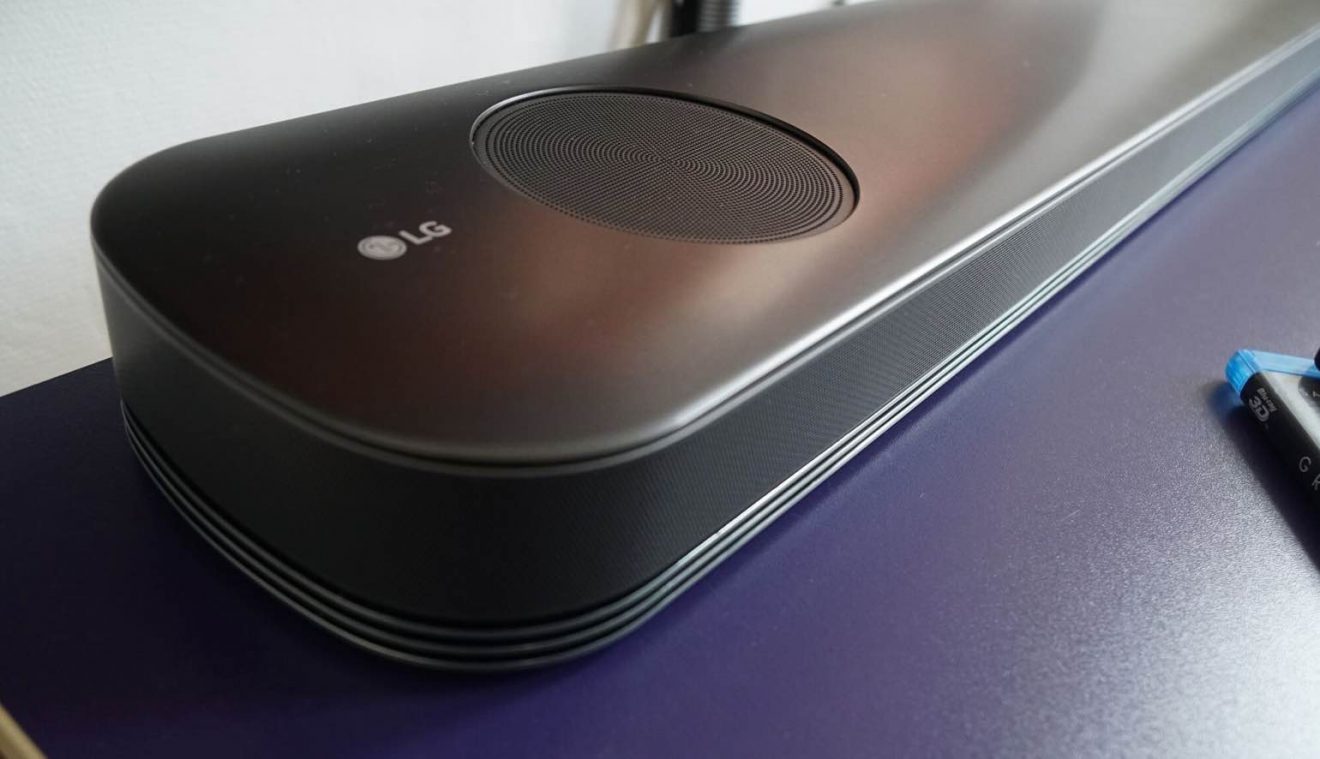
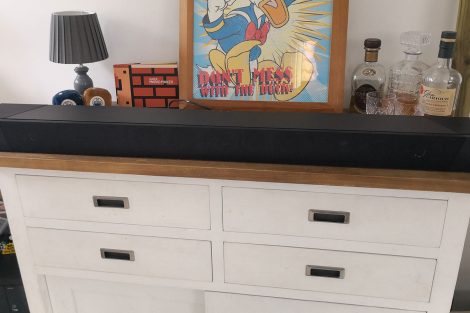

Add Comment